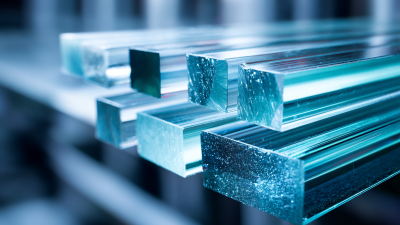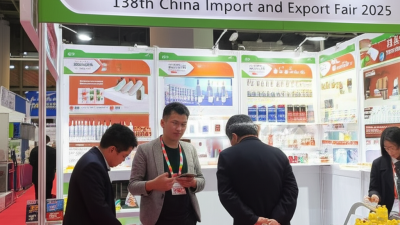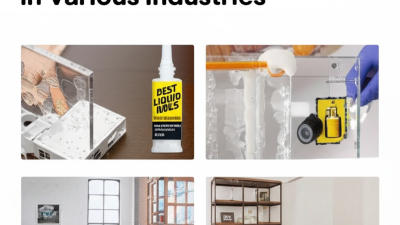Inquiry
Form loading...
In the evolving landscape of modern construction, sustainability has become a pivotal focus, driving innovations that enhance energy efficiency and reduce environmental impact. One such advancement is the use of Insolating Glass Silicon Glue, which plays a crucial role in bonding insulating glass units (IGUs) that are essential for energy-efficient building designs.

According to a report by the International Energy Agency (IEA), buildings account for nearly 40% of global energy consumption, highlighting the importance of effective insulation solutions. The implementation of high-performance adhesives such as Insolating Glass Silicon Glue not only ensures structural integrity and longevity but also significantly improves thermal performance, contributing to reduced heating and cooling costs.
Furthermore, as reported by the Transparency Market Research, the global market for insulating glass is expected to reach $27 billion by 2025, emphasizing the growing recognition of the essential role that such advanced materials play in promoting sustainable construction practices.
 Insulating glass silicon glue plays a crucial role in modern construction, particularly in enhancing energy efficiency and sustainability. By sealing the gaps between insulating glass units, this specialized adhesive helps minimize thermal bridging, which can lead to significant energy loss. As buildings account for a substantial percentage of global energy consumption, the application of high-performance silicon glue becomes essential in meeting energy standards and regulations. This not only aids in reducing heating and cooling costs for occupants but also contributes to lower carbon footprints in line with sustainable development goals.
Insulating glass silicon glue plays a crucial role in modern construction, particularly in enhancing energy efficiency and sustainability. By sealing the gaps between insulating glass units, this specialized adhesive helps minimize thermal bridging, which can lead to significant energy loss. As buildings account for a substantial percentage of global energy consumption, the application of high-performance silicon glue becomes essential in meeting energy standards and regulations. This not only aids in reducing heating and cooling costs for occupants but also contributes to lower carbon footprints in line with sustainable development goals.
Moreover, the durability and flexibility of silicon glue are vital in ensuring that insulating glass assemblies withstand various environmental conditions. This resilience is especially important in regions prone to extreme weather conditions, as it helps maintain the integrity of the building envelope. The use of insulating glass silicon glue also allows for innovative architectural designs, enabling larger glass surfaces that enhance natural light while still providing optimal insulation properties.
By integrating this advanced adhesive technology, modern construction can achieve both aesthetic appeal and functionality, marking a significant step towards environmentally responsible building practices.
Silicon glue, particularly when utilized with insulating glass, plays a pivotal role in enhancing the sustainability of modern construction. One of its key properties is its exceptional adhesive strength, which ensures that various building materials, such as glass and aluminum, bond securely. This strong adhesion not only improves the structural integrity of buildings but also minimizes the risk of air and water infiltration, contributing to better energy efficiency. By reducing energy loss, silicon glue helps in maintaining optimal indoor climates, aligning with sustainable building practices that prioritize environmental conservation.
In addition to its bonding capabilities, silicon glue is known for its flexibility and durability. These characteristics allow it to withstand temperature fluctuations and mechanical stresses, ensuring long-lasting performance in various weather conditions. Moreover, silicon glue is formulated to be resistant to UV radiation and extreme temperatures, which enhances the lifespan of building envelopes. This durability translates into lower maintenance costs and decreased resource consumption over time, making it a valuable component in the pursuit of sustainable construction solutions. As the construction industry continues to focus on eco-friendly practices, the properties and benefits of silicon glue become increasingly essential in the development of resilient and sustainable buildings.
In modern construction, insulating glass silicon glue plays a pivotal role in enhancing energy efficiency. This adhesive provides a reliable seal between glass panes, contributing to the overall thermal performance of windows and facades. By preventing air leaks and moisture ingress, it helps maintain stable indoor temperatures, ultimately reducing the need for excessive heating and cooling. This is particularly crucial in energy-efficient designs where minimizing energy consumption is a top priority.
Moreover, the applications of insulating glass silicon glue extend beyond mere sealing. It supports the structural integrity of insulating glass units, enabling architects and builders to create larger glass spans without compromising safety or efficiency. The flexibility of this glue accommodates building movements and thermal expansion, making it ideal for various climates. As a result, it not only meets aesthetic demands but also aligns with sustainability goals, fostering a more eco-friendly approach in modern architectural practices.
| Application Area | Description | Advantages | Impact on Sustainability |
|---|---|---|---|
| Residential Buildings | Used for sealing insulating glass units in windows. | Improves thermal performance, reduces noise. | Enhances energy efficiency and comfort in homes. |
| Commercial Buildings | Institutions and offices utilize insulating glass for large windows. | Increases natural light while minimizing glare. | Contributes to LEED certification for green buildings. |
| Curtain Walls | Used for the attachment of glass panels to frame systems. | Strengthens building envelopes and weather resistance. | Reduces lifecycle carbon footprint of buildings. |
| Skylights | Seals insulated glass in overhead glazing solutions. | Enhances natural lighting and aesthetic appeal. | Promotes daylighting, reducing artificial lighting usage. |
| Energy Efficient Retrofits | Replacement of older windows with high performance glazing. | Lower energy bills and improved comfort levels. | Extends lifespan of buildings while minimizing energy use. |
Silicon glue plays a pivotal role in modern construction, particularly in enhancing building longevity and reducing maintenance efforts. As a durable adhesive, it is designed to withstand extreme weather conditions, thus ensuring that structures remain intact over time. This resilience translates to fewer repairs and replacements, minimizing disruption to occupants and preserving the aesthetic integrity of the building's exterior. Furthermore, the flexibility of silicon glue allows it to accommodate the natural expansion and contraction of materials, which is crucial in preventing cracks and other forms of damage that could impact a building's lifespan.
Moreover, the use of silicon glue aligns with sustainability goals in construction. By extending the life of buildings and reducing the need for frequent renovations, silicon glue contributes to less waste generation and decreased consumption of resources. This environmentally friendly adhesive reduces the reliance on more traditional, less sustainable materials and practices. Additionally, the lower maintenance requirements associated with silicon-glued assemblies further help decrease the environmental footprint over the building’s lifecycle, making it a smart choice for modern, sustainable construction practices.
This chart illustrates the impact of silicon glue on building longevity and maintenance aspects, indicating its advantages in terms of durability, reduced maintenance frequency, cost efficiency, and energy savings in modern construction.
The APAC pressure sensitive adhesives (PSA) market is poised for substantial growth, projected to reach USD 7 billion by 2025, reflecting an annual growth rate of approximately 5.5%. This upward trajectory is driven by the increasing demand for sustainable construction practices, where silicone adhesives play a pivotal role. As construction projects prioritize durability and environmental responsibility, the integration of insulating glass silicon glue, a sophisticated adhesive technology, is becoming more prevalent. This trend is not just a cosmetic upgrade; it enhances thermal insulation and energy efficiency in modern buildings, aligning with global sustainability goals.

Tips: When selecting adhesives for construction, consider products that offer both high performance and environmental benefits. In particular, silicone-based adhesives can provide superior bonding capabilities while also minimizing harmful emissions. Moreover, organizations should stay updated on emerging technologies that enhance adhesive sustainability, such as bio-based or recyclable options, which are gaining traction in the PSA market.
In addition to these advancements, industry experts highlight some challenges facing the market, including fluctuating raw material prices and stringent regulatory standards. However, the focus on sustainable building materials and practices is leading to innovations that address these issues. As manufacturers invest in research and development, we can expect a new generation of silicone adhesives that not only meet the demands of construction but also contribute to a greener planet.






